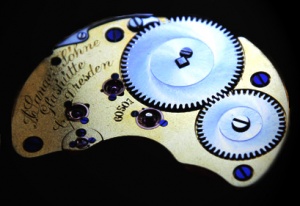Three-quarter plate: Unterschied zwischen den Versionen
Zur Navigation springen
Zur Suche springen
| (Eine dazwischenliegende Version desselben Benutzers wird nicht angezeigt) | |||
| Zeile 1: | Zeile 1: | ||
| − | |||
| − | |||
[[Bild:Dreiviertel-Platine.jpg|thumb|Three-quarter plate]] | [[Bild:Dreiviertel-Platine.jpg|thumb|Three-quarter plate]] | ||
The three-quarter plate was introduced in [[Glashütte]] by [[Adolph Lange]] in [[1864/de|1864]]. Since then, it has been a typical feature of Lange watches. It accommodates the counter-bearings of the going train and enhances the stability of the movement. | The three-quarter plate was introduced in [[Glashütte]] by [[Adolph Lange]] in [[1864/de|1864]]. Since then, it has been a typical feature of Lange watches. It accommodates the counter-bearings of the going train and enhances the stability of the movement. | ||
[[Category:Glossary]] | [[Category:Glossary]] | ||
| + | |||
| + | |||
| + | [[de:Dreiviertel-Platine]] | ||
| + | [[en:three-quarter plate]] | ||
| + | [[es:Platina tres cuartos]] | ||
| + | [[fr:Platine trois-quarts]] | ||
| + | [[it:Platina a tre quarti]] | ||
| + | [[nl:driekwart platine]] | ||
| + | [[ru:трехчетвертная платина]] | ||
Aktuelle Version vom 20. Mai 2013, 00:01 Uhr
The three-quarter plate was introduced in Glashütte by Adolph Lange in 1864. Since then, it has been a typical feature of Lange watches. It accommodates the counter-bearings of the going train and enhances the stability of the movement.
